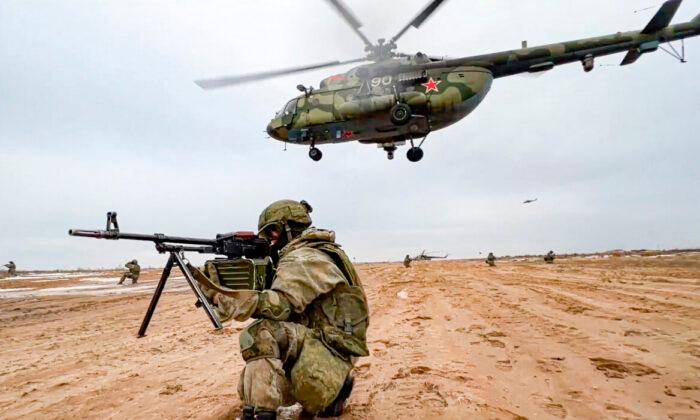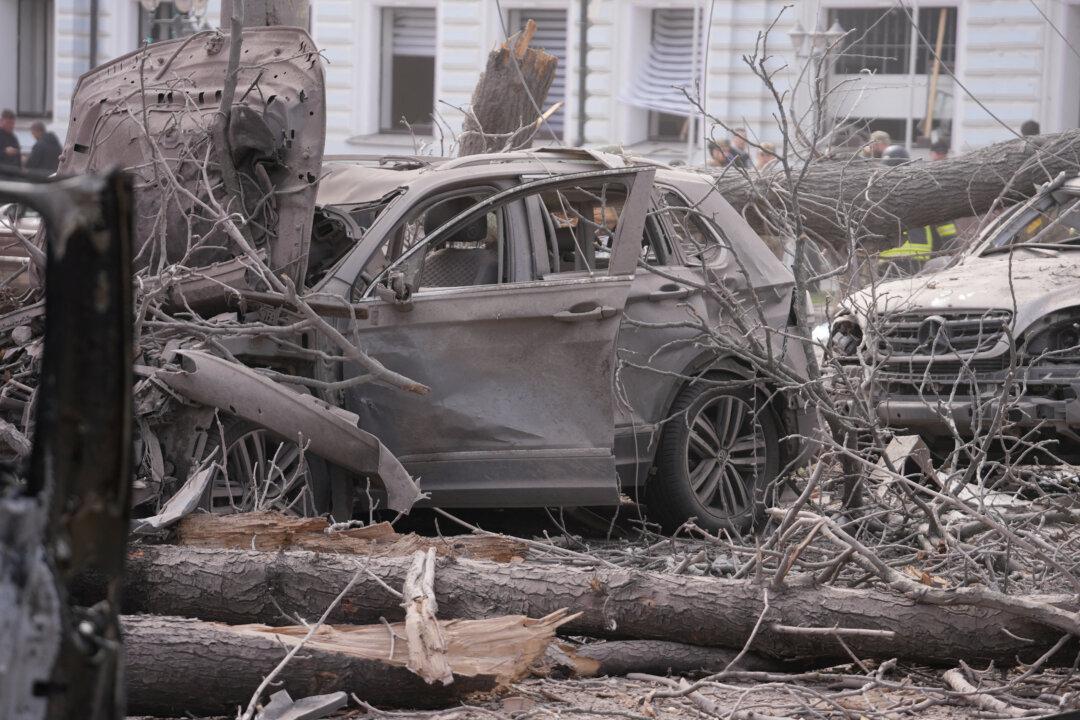Strategic allies Russia and Belarus began holding wide-ranging joint military drills on Jan. 16, according to official statements from both countries.
The exercises, which are set to continue until Feb. 1, will likely fuel fears of a possible Russian advance on Kyiv, which sits only 95 miles south of the Belarusian border.
According to the Belarusian Defense Ministry, the “joint tactical flight drills” are aimed at improving “operational compatibility in the collective achievement of combat training objectives.”

More specifically, the drills are meant to rehearse air reconnaissance, joint aerial patrols, the provision of air support for ground operations, tactical assault landings, and cargo deliveries, the ministry said in a statement.
Last week, Belarusian military officials said the “aviation component” of the Russian Aerospace Forces had arrived in the country to take part in the scheduled exercises.
On Jan. 11, Moscow reorganized the command structure of its ongoing “special military operation” in Ukraine, which will soon enter its 12th month.
Gen. Valery Gerasimov was made supreme commander of operations, replacing Gen. Sergey Surovikin, who returned to his previous role as commander of the Russian Aerospace Forces.
Fears of Russian Cross-Border Assault
Pavel Muraveiko, a high-ranking Belarusian defense official, has said the two-week-long series of drills was entirely “defensive in nature.”“It is a set of measures to prepare Belarusian and Russian aviation to carry out the relevant combat missions,” Muraveyko said in a Jan. 15 statement on the Belarusian Defense Ministry’s Telegram account.
Nevertheless, cooperation between Moscow and Minsk has raised concerns in Kyiv that Belarus could be used as a staging ground for a Russian cross-border assault, as was seen in the first weeks of the conflict.
According to military experts, a southward Russian offensive from Belarusian territory could threaten the supply of weapons coming to Ukraine from neighboring Poland.

It would also force Kyiv to divert badly needed resources away from the southern and eastern fronts, where fierce fighting remains ongoing.
Russian forces recently overran the town of Soledar in the Donetsk region and are now reportedly advancing on nearby Bakhmut, a key transport hub for Ukrainian troops and equipment.
Last week, after visiting Ukraine’s western Lviv region, Ukrainian President Volodymyr Zelenskyy warned that Kyiv “must be ready” to counter a possible Russian incursion from Belarusian territory.
On Jan. 11, the Ukrainian military held its own drills near the border with Belarus, where Ukrainian troops reportedly practiced ambush and urban-warfare techniques.
Muraveyko has described the situation along the 675-mile border as “not very calm” and has accused Ukrainian forces of staging “provocations” near Belarusian territory.
Minsk Warns of ‘Collective Response’
Since 1999, Russia and Belarus have been bound by a “Union State” treaty aimed at bolstering economic and military ties between the two countries.Yet despite their longstanding strategic partnership, Belarus has yet to play an active role in the ongoing fighting between Russian and Ukrainian forces.
Belarusian President Alexander Lukashenko has repeatedly said he has no intention of sending Belarusian troops into Ukraine to fight alongside their Russian counterparts.
However, a high-ranking Russian diplomatic official recently said that the “use of force” by Kyiv against Russia or Belarus would draw a “collective response” from both countries.
Under the terms of the Union State treaty, “any use of force by the Kyiv regime, or a Ukrainian military invasion of Belarus or Russia, would be enough to trigger a collective response,” Russian Foreign Ministry official Alexey Polishchuk told Russian state-owned news agency TASS on Jan. 13.
“But it would be up to the two countries’ political and military leadership to decide whether to respond—and in what way,” he said.
In October 2022, Moscow dispatched thousands of troops—and substantial amounts of military hardware—to Belarusian territory.
Soon afterward, the Russian air force began staging regular patrol flights over the Belarus–Ukraine border.
Late last month, Belarusian officials confirmed that Russian-deployed Iskander missile systems and S-400 air-defense systems were up and running on Belarusian territory.
On Dec. 19, 2022, Russian President Vladimir Putin paid a rare visit to Minsk, where he held closed-door discussions with Lukashenko.
Putin was accompanied on the one-day visit by Russian Foreign Minister Sergey Lavrov and Russian Defense Minister Sergei Shoigu.





